#eulachon
Explore tagged Tumblr posts
Note
Happy birthday!
I give you a very silly fish!

Thaleichthys pacificus, aka, eulachon or hooligan
They’re also known as candlefish, and they’re used for food, trade, or left to rot in a hole to harvest the oil by Alaskan natives!
EEEEEEEEEEEEE THABK YOU
32 notes
·
View notes
Text
Okay, mis petite amores, today’s fish is a little less flashy, but still - they glow. In this post you will learn about fish candles, overland grease trails, and a theory on the state of Oregon.
I would like to introduce you to Thaleichthyes pacificus, also known as the eulachon (you-luh-con, in the lower 48; hooligan in Alaska; oolighan in Chinook Jargon)Also known as the candlefish.
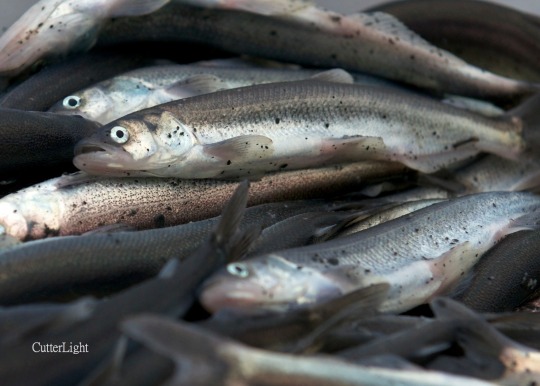
These are tiny smelt - but they are also extremely fatty fish.
With up to 15% of their body weigh being fat tissue, if you dry one out and string it on a wick, YOU CAN LITERALLY BURN IT LIKE A CANDLE.
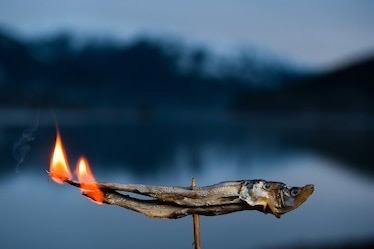
They’re anadromous, like salmon, so they live in the ocean during most of their lives but spawn in freshwater rivers - though they’re rather less predictable.

Indigenous communities on North America’s Pacific coast included eulachon as part of their diet, and often processed them for oil - which is done by letting them rot in a hole in the ground for about a week before adding boiling water and skimming the oil off the top.
Eulachon oil was so widely traded between coastal tribes and inland tribes that the trade routes were called grease trails.
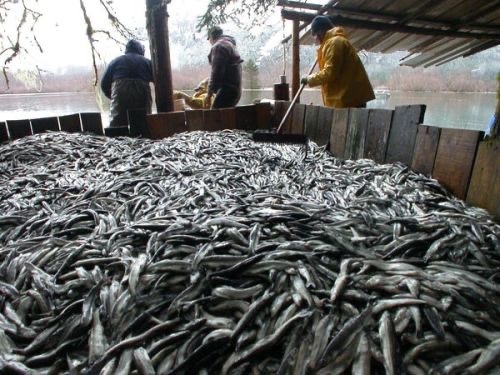
In fact, one archaeologist argued in a paper that the name of the state of Oregon was derived from the Chinook Jargon word - oolighan.

A few distinct population segments of eulachon are threatened or endangered, so at this point I would not in good conscience recommend setting any on fire.
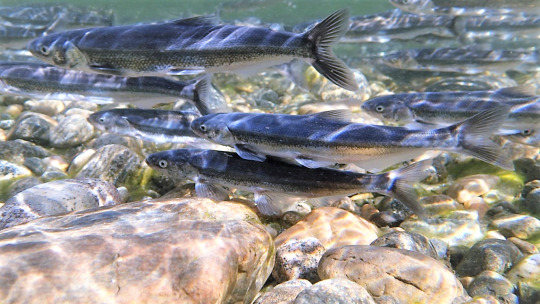
87 notes
·
View notes
Text
I know everything sucks right now but if you have the energy to care about the ooligan please do
1 note
·
View note
Text
Introduction To Candle Magic
Ancient Craft & Occultism
___
By KB

Introduction
Welcome back witches in training! We've been covering a lot of ground bases lately, especially within the realms of spellwork. Today, we're going to take that a bit further by opening our horizons to the infinite world of Candle Magic! In this lesson, we're going to discuss basic color magic, the history of candles, and how to use candles in your craft. Let's get to it!
A Brief Candle History
The exact origin of the candle is quite a debate among historical scholars, but there is a large sum of evidence that suggests candles made of beeswax were used in Egypt and Crete as early as 3000 BCE. Other early candles were fashioned using tallow-soaked tapers manufactured from fibrous materials like rushes. Rushlights were one of the first types of enclosed light we are aware of, yet they were unlike candles as we know them today because they lacked a wick. The impoverished continued to utilize them for centuries because they were also inexpensive to produce.
It may come as no surprise that the Romans are credited with creating the first wicked candles by continuously dipping a roll of papyrus into tallow, a converted form of beef or mutton fat, while wrapping it around a length of twine. Candles were still used in the same manner, but they had superior quality and a longer lifespan than rushlights.
However, candle production was not only practiced by the Romans. Wicked candles were "invented" by numerous other ancient civilizations who also used local plant-based waxes. The eulachon fish, which is so oily that when dried, it would burn like a candle when you ignite one end, was used as a candle by tribes in Alaska and Canada. The Chinese used wrapped ricepaper as wicks. In India, wax was created from the fruit of the cinnamon tree.
Candles, in any form, were a significant component of religious rites throughout this time. The Jewish Festival of Lights, Hanukkah, was originally documented around 165 B.C. Constantine, the Roman emperor between 306 and 337 A.D., mandated the use of lamps during Easter celebrations. Indeed, from roughly the time of Constantine, lights have played a significant role in religious events and signify the purifying light of God.
Candle flames were seen by ancient peoples to reveal enigmatic things. One could experience an altered state of consciousness and see gods, spirits, or the future by gazing into a flame. In a magic ceremony for "dreaming true," or getting information from dreams, the late Egyptians of the third century B.C. utilized lamps and possibly candles. He retired to a pitch-black cave that faced south and sat there gazing into a flame till he saw a god. Then he went to sleep, hoping that the deity would show up in his dreams and provide him with the answers he was looking for.
The Roman Christian scholar Tertullian fiercely objected to the ancient Pagan practice of lighting candles and lights during religious ceremonies, calling it "the useless lighting of lamps at noon." Candles and lamps were used in Christian rites from the fourth century, but candles weren't put on church altars until the later Middle Ages, starting in the twelfth century. Consecrated holy candles are used in ceremonies for blessings, atonement for sins, and the exorcism of demons, all of which were instituted by the Catholic Church.
Using Candles In The Craft
Candles have long been used as versatile tools, but in witchcraft, they can also be used for divination, spirit sensing, casting spells, and a variety of other things. Let's jump right in.
Divination - Reading the wax and observing how the candle really burns are the two most popular techniques for candle divination. You must observe the candle's burning pattern, including its height, flickering, and the presence of many flames, in order to make a prediction based on how it burns. Two flames could indicate assistance from the afterlife in achieving your objective. Even the hues of the flame may give you a clue as to how well your efforts are going. However, there is no agreement on what these indications signify. While some practitioners hold that a candle that burns tall and strongly indicates that one's request will be granted, others draw attention to the fact that the wick's length and quality, as well as an air vent, can affect how the candle burns. Prioritize your intention over the candle's burning process. You can always read the wax once it hardens, or pour the wax directly into cold water for it to harden and then interpret the symbols, much like you would with bone throwing, or scrying. Personally, I also like to pay attention to the smoke and interpret the way the smoke from the candle flows in order to interpret surrounding energies.
Spirit Work - Fire scrying is the most common way to communicate with spirits, and as it's the only method with candles I have experience with, that's what I will be discussing here. I encourage you to do your own research into spirit communication outside of my suggestion, because I'm sure there are plenty other methods out there. Again, there is no base consensus in a means to interpretation, as spirits and practitioners alike have different ways of communication. Just like with any other scrying, its imperative to stay connected to your personal energy while connecting with surrounding energy to properly interpret the signals you are receiving. Connecting with deities is also possible using this method of Candle Magic.
Rituals/Spellwork - In rituals and spells, candles are used to increase vibrations, represent specific elements and other important objects or creatures, use symbolism, and seal items like letters or spell bottles. Even candle spells can be created simply lighting a candle with intention. It is very common to carve, dress, and anoint candles in aid for ritual and spellwork as well. Fire being the main force driving the work, of course.
Worship - Candles are often used as offerings for various deities. Symbolism, color, and dressings can all play a part of this as well. They are also used as a beacon for an entity to guide you through your working.
Candle Correspondences
When undertaking serious candle work, choosing the right candle colors is crucial. Each hue has a unique meaning and possesses unique abilities. It's crucial to pick colors that align with your aims while working with candles in spells or rituals. Please remember that this is a very basic list and that the things you will read in your personal correspondence are far more significant than anything you will read here.
White - Attraction, Purification, Protection, Balance, Clarity, Grounding, Healing, Hope, Innocence, Optimism, Peace, Truth, Willpower
White can take the place of any other color when not available. Just a bit of visualization is required.
Black - Acceptance, Afterlife, Banishing, Binding, Determination, Endings, Justice, Loss, Release, Break, Security, Grief, Negativity, Patience, Persistence, Rebirth, Strength, Self Control
Red - Assertiveness, Courage, Creativity, Energy, Desire, Loyalty, Motivation, Power, Survival, Change
Yellow - Action, Communication, Learning, Finances, Business, Intellect, Inspiration, Knowledge, Wisdom, Stimulation
Pink - Acceptance, Affection, Beauty, Compassion, Healing, Family, Harmony, Kindness, Longevity, Nurturing, Partnership, Prosperity
Green - Abundance, Agriculture, Beauty, Creativity, Family, Fertility, Healing, Luck, Environment, Nurturing
Purple - Authority, Enlightenment, Spirituality, Emotions, Imagination, Influence, Truth, Wisdom, Overcoming Fear
Orange - Adaptive, Ambition, Confidence, Courage, Discipline, Energy, Freedom, Justice, Positivity, Pleasure, Stimulation, Travel
Blue - Honesty, Truth, Trust, Dreams, Sleep, Mental, Wisdom, Leadership, Fertility, Marriage, Healing, Study
Brown - Endurance, Animals, Balance, Courage, Grounding, Stability, Protection
Silver - Awareness, Intuition, Money, Purification, Potential, Stability, Success, Celestial
Gold - Abundance, Ambition, Money, Happiness, Power, Influence, Solar energy
Even if you aren't aware of it, the type of candle and the type of wax it is made of may have an impact on your craft. It can all come down to functionality or magical implications.
Taper Candles
Taper candles are tall, thin candles with a tapered top; they are often placed in vintage, smaller candle jars and are more ornamental and symbolic. Shorter taper candles are typically used to seal objects with wax. They can, however, be utilized for any task.
Pillar Candles
There are many different types of pillar candles, but these are the ones I see used almost exclusively. They differ from being short and fat to being tall and slim. They can be utilized for a variety of purposes, but I've found that rituals are where they're most useful.
Votive Candles
Votive candles are little and barely taper more at the base. They are frequently placed in glass candle holders and are used as offerings to deities. Given that their modest, tapering size is what makes them votives, their sizes rarely fluctuate. But they do come in a variety of colors. They are often white.
Tealights
Tealights are tiny, thin, and short candles. You can use them to make offerings, perform spells and rituals, decorate, or even keep wax warmers warm. I frequently observe this kind of candle being used, largely because they are the least expensive candles available.
Now, let's go over some of the different wax types.
Beeswax
It used to be difficult and dangerous to obtain beeswax, which added to the candle's mystique and spiritual power. Beeswax is a natural substance that burns more slowly, making it a premium item among contemporary candle spiritual practitioners; yet, because of its price, it may not be the best choice. Beeswax candles are available in a wide variety of shapes, sizes, and hues and can be rolled, poured, or dipped. Longer ancestral rituals that demand higher vibrations and purpose work best with these candles.
Soy
People who use earth magic sometimes like soy candles since they are natural. Although they tend to burn for a shorter period of time than beeswax candles, they keep fragrances quite well. When dressed, they can also be extremely fragile and challenging to mold or carve. The majority of soy candles are already housed in glass. They are most effective when utilized in ancestral rituals for healing and rebirth.
Paraffin
Since it's a byproduct of the petroleum industry, many people consider it to be less natural than the available alternatives. The fact that it releases chemicals like toluene into the air makes it a poor choice for poorly ventilated areas. Other than providing the foundation for candles, I haven't discovered any sources that discuss the magickal powers of paraffin itself. I found a few for petroleum jelly, which is frequently used as a foundation for herbal salves, but they mainly praised how simple it was to use as an ointment. Even our non-human ancestors may have used petroleum, according to some sources, which makes it a solid foundation for ancestor magic.
#elder witch#baby witch#witchblr#witchcraft#beginner witch#goth#green witch#kitchen witch#wicca#witch#dark witchcraft#witch tips#witchythings#traditional witchcraft#witchraft 101#tarotblr#astroblr#tarot#spiritual
263 notes
·
View notes
Text

Hobiyee Earrings
Karen Francis
from the website: Hobiyee is Nisga’a New Years. Hobiyee comes from the phrase “Hobixis hee!” meaning the “moon is in the shape of the hoobix.” The hoobix is the bowl of the Nisg̱aʼa wooden spoon. Hobiyee signifies the potential for an abundant harvest (or filled spoon) if the crescent moon’s edges point upward. When the moon is shaped like a wooden spoon and its position aligned with the brightest star it let people of the area know the harvest season arrived. The moon rising tells us that the eulachon has arrived. The first resource that comes back from the ocean and following that the moon calls all the different species of salmon to our land
80 notes
·
View notes
Text





[ DIGITAL - PART 3 ]
and finally, here's part 3, we've reached the end!!
oc creators (in order of appearance; left -> right)
artfight - orange
instagram - purple
twitter - pink
esker and zoey - mine (left) and @saladski1 (right)
esra and mneme - @50ruins (left) and @salaninos (right)
eulachon - @cypresssalmon
jayden - @/midorisrtail (deviantart)
"pastelle" 4th doctor - @mypersonalships
i have excluded some attacks as i do not yet have permission from the creators to post them; if you want my attack towards you to be removed or credit source to be changed, please do not hesitate to dm me!! i'll remove or change it asap (★≧▽^))★☆
that's it folks!! hope you enjoyed and happy artfight! this was my first time participating so i hope i didn't do bad ( ̄▽ ̄*)ゞ
#art#drawing#artfight#artfight 2023#team vampires#team vampire#digital art#digital painting#other people's ocs#other peoples characters#glycherriiart#glycherriioc (because theres only one of them)
10 notes
·
View notes
Text
Prayer among the Kwakwiutl
Kwakwiutl Ethnography, Franz Boas. note that the original text includes the kwakwiutl words for but im just typing up the translations because i dont have the symbols. my notes in parentheses+italics
All nature, the heavenly bodies, rocks and islands, waterfalls, animals, and plants are being of supernatural power who man can approach with prayer, whose help he can ask, and to whom me may express his thanks. Prayers do not have a fixed form that makes them potent by the power of the repetition of the formula. They are all similar in form but express the emotion that fills the one who appeals for help or renders his thanks. At the end of a prayer, the supplicant himself answers, "Hau, it will happen that way".
The powers are addressed by honorific names; animals, by descriptive names that differ from their everuday names, without being exactly honorific or sacred. All are addressed as "Supernatural One". The sun is the Great-Chief or Father. Dangerous places are called Old-Man, Great-Owner-of-the-Weather; plants used as food or medicine are called Life-Owner, Long-Life-Maker
A number of these terms have the ending "-Making-Woman" like the last or like Rich-Making-Woman, and Right-Making-Woman. Evil powers are named in analogous forms, such as Short-Life-Maker-Woman and Killing-Woman. I am not at all certain whether these terms are nowadays in any way felt as personifications. They are also applied to very specific action, such as such as Sore-Healing-woman and in ordinary speech, such as poor (literally "pitiable-making-woman"), which is used as an adjective.
The olachen (note: usually eulachon or candlefish, a ~6-inch fatty river fish) is addressed as Chief-of-the-Upper-Side-of-our-World (?! what could this mean? perhaps because they swim up rivers to spawn, towards the mountains?). Salmon are generally called Swimmers. The halibut is called Born-to-be-Giver-in-the-House, Scenting-Woman, Flabby-Skin-in-the-Mouth, Squint-Eye; the beaver Throwing-Down-in-one-Day, Tree-Feller, Weather-Owner (connection to "owner of the weather" for dangerous places? perhaps because beavers make trees fall, dangerous, and falls from the sky like weather?)
Halibut Hooks are called Younger-Brothers
When praying, the supplicant stands still or sits down in front of the one he is praying to and directs his eyes at him.
At sunrise the Indian may pray to the sun, "Welcome, Great Chief, Father, as you come and show yourself this morning. We come and meet alive. Oh, protect me and let nothing evil befall me today, Father!"
"Look at me, Chief, that nothing evil may befall me this day which is made by you as you desire, Great-One-Walking-to-and-fro-all-over-the-World, Chief!"
When caught in a gale at sea, the canoe man prays to the sun, "Press down the sea in your world, Great Chief, Father, that it may become good, that your world may become right on the water, Great Father!"
Dangerous rocky islands and points are called Old-Man. In passing one of these in rough water, the traveler will pray "Look at me, Old-Man! Let the weather made by you spare me (so the source of danger from the weather is also the cause of the weather? perhaps sense that the rocks want to be broken up on? almost like cui bono), and, pray, protect me that no evil may befall me while i am traveling on this sea, Old-Man, that i may arrive at the place to which I am going, Great-Supernatural-One, Old-Man", or when passing in good weather,
"Oh Old Man, I pray before you. Have mercy and watch the weather that you are making, that it may remain calm at sea, Good-Supernatural-One; protect me, that the words of those who hate me may not penetrate me, that what they wish to do to me may just go into them" (belief that bad weather is caused by enemy magic? unclear)
A cascade in Knight Inlet is so high and full that it causes a strong wind and heavy spray at its foot. When the Indians go there for olachen fishing, they undress, and the whole tribe visit the falls in their canoes. One man stands up in his canoe and prays, "Welcome, Old-Man, we have come and meet alive. I have asked you for this, Great-Supernatural-One, last year when I came, I beg you to have mercy and to blow off all evil from us, all our sickness, Great-Supernatural-One, so that we may come to life. Protect our sickness, Great-Supernatural-One, and also, please, let the weather you are making be fine, Great-Good-Supernatural-One, you who are not a common person, Old-Man"
The workman will also pray to the material or tool he is going to use in his work
[section about praying to a tree you are about to fell, a trap you are building, and a net you are using to catch fish]
The hunter prays to his game or other animals he encounters. After killing a grizzly bear, he says, "O Great-Supernatural-One, you are lying there, overcome by me, friend! I have struck you first with my death bringer. Listen to me, Supernatural-One, now i will take by war your power of not respecting anyone or anything, of being fearless, and your wildness, great, good Supernatural-One"
After killing a beaver, he prays, "Welcome, friend Throwing-Down-in-One-Day, you Tree-Feller, for you have agreed to come to me. I wanted to catch you because I wish you to give me your ability to work, that I may be like you, for there is no work that you cannot do, you Throwing-Down-in-One-Day, you Tree-Feller, you Owner-of-Weather, and also that no evil befall me in what I am doing, friend"
3 notes
·
View notes
Text
Prefix: Eulachon- (Coastal, NorCal)
Also written as “ooligan” or “hooligan”, for some weird reason, Eulachons are saltwater fish that prefer colder waters. They live in a range stretching from Alaska to the northern part of California.
Locations: In the northern coast.
Use: A grey-brown cat.
3 notes
·
View notes
Photo

The world you live in.
41 notes
·
View notes
Photo

The most beautiful mountains in Europe: The Italian Dolomites [OC][6210 × 3736] Check this blog!
3 notes
·
View notes
Photo

Seal Feast Bowl, 19th century, Brooklyn Museum: Arts of the Americas
The object is a carved feast bowl in the form of a seal. The bowl is saturated with eulachon or candlefish oil, which was eaten as a delicacy and used to soften dried berries. Although the bowl is cleaned by conservators from time to time, the oil continues to advance towards the surface, especially from the interior where the oil is heavily embedded. The object is stable and in fair condition. There is an old crack in one end that is stable. There are two round holes through the bottom of the bowl, one at each end. Size: 5 1/4 x 14 1/4 x 8 1/2 in. (13.3 x 36.2 x 21.6 cm) Medium: Wood
https://www.brooklynmuseum.org/opencollection/objects/4922
4 notes
·
View notes
Photo

The full book title contains 3777 words and reads as follows: 'The historical development of the Heart i.e. from its formation from Annelida: Clam worm, Seamouse, Lugworm, Megascolex, Tubifex, Pheretima, Freshwater leech, marine leech, land leech. Arthropoda: Ladybird, Krill, Rock Barnacle, Root-headed Barnacle, Copepod, Silverfish, Cairns birdwing, Silver - spotted skipper, Scutigera, Cray fish, Large white, Andonis blue, Camberwell beauty, Tiger swallowtail, Regent skipper, Black – veined white, Green – underside blue, Blue Morpho, Apollo, Guava skipper, Cleopatra, Large copper, Millipede, Orb spider, Black widow spider, Giant crab spider, Wolf spider, Bird – eating spider, Tenebrionid beetle, Green Tiger beetle, African goliath beetle, Scolopendra, Diving beetle, African ground beetle, New guinea weevil, Barnacle, Lobster, Shrimp, Woodlice, Mite, Prawn, Housefly, Butterfly, Monarch butterfly, Peacock butterfly, Honey bee, Fairy shrimp, Horsehoe crab, Tick, Bluebootle, Froghopper, Yellow crazy ant, Water flea, Sea spider, Fiddler crab, Shiny spider crab, Hermit crab, Sail swallowtail, Red admiral, Morpho butterfly, Desert locust, Stephens island weta, Speckled bush cricket, Mole cricket, Dung – beetle, Euthalia ynipardus, Small blues, Termite, Hornet, Mosquito, Garden spider, Tarantula, Desert hairy scorpion, Emperor dragon – fly, Moth, Centipede, Wood ant, Stag beetle, Indian red admiral, Blue admiral, Harvestman, Hoverfly, Shield bug, Assassin bug, Cicada, Coreid bug, Rose aphid, Water – boatman, Wasp, June bug, Large tortoiseshell, Frog beetle, Mexican red – legged tarantula, Paintedlady, Sydney funnelweb spider, Small tortoiseshell, Mountain bumble bee, Trapdoor spider, Jumping spider, Daddy longlegs spider, Orchind bee, Asian carpenter bee, Parasitic bee, House spider, Giant longhorn beetle, Flea, Bedbug Beetle, Cockroach, Scorpion, Spider, Ant, Gnats, Grasshopper, Silver fish, Crab, Great green bush cricket, Elephant hawk – moth. Mollusca: Neomenia, Chaetoderma, Chiton, Lepidopleurus, Apple snail, Sea hare, Sea lemon, Dentalium, Freshwater mussel, Marine mussel, Pearl oyster, Cuttlefish, Giant squid, Chambered fish, Devilfish. Fishes or Pisces: African glass catfish, African lungfish, Aholehole, Airbreathing catfish, Alaska blackfish, Albacore, Alewife, Alfonsino, Algae eater, Alligatorfish, Alligator gar, Amberjack - Seriola dumerili, American sole, Amur pike, Anchovy, Anemonefish, Angelfish, Angler, Angler catfish, Anglerfish, Antarctic cod, Antarctic icefish, Antenna codlet, Arapaima, Archerfish, Arctic char, Armored gurnard, Armored searobin, Armorhead, Armorhead catfish, Armoured catfish, Arowana, Arrowtooth eel, Asian carps, Asiatic glassfish, Atka mackerel, Atlantic Bonito (Sarda sarda), Atlantic cod, Atlantic herring, Atlantic salmon, Atlantic Sharpnose Shark - Rhizoprioltodon terraenovae, Atlantic saury, Atlantic silverside, Australasian salmon, Australian grayling, Australian herring, Australian lungfish, Australian prowfish, Ayu, Baikal oilfish, Bala shark, Ballan wrasse, Bamboo shark, Banded killifish, Bandfish, Banjo, Bangus, Banjo catfish, Bank Sea Bass, Barb, Barbel, Barbeled dragonfish, Barbeled houndshark, Barbel-less catfish, Barfish, Barracuda, Barracudina, Barramundi, Barred danio, Barreleye, Basking shark, Bass, Basslet, Batfish, Bat ray, Beachsalmon, Beaked salmon, Beaked sandfish, Beardfish, Beluga sturgeon, Bengal danio, Betta, Bichir, Bicolor goat fish, Bigeye, , Bighead carp, Bigmouth buffalo, Bigscale, Billfish, Bitterling, Black angelfish, Black bass, Black dragonfish, Blackchin, Blackfin Tuna - Thunnus atlanticus, Blackfish, Black neon tetra, Blacktip reef shark, Black mackerel, Black scalyfin, Black sea bass, Black scabbardfish, Black swallower, Black tetra, Black triggerfish, Bank Sea Bass aka Yellow Sea Bass - Centropristis ocyurus, Bleak, Blenny, Blind goby, Blind shark, Blobfish, Blueline Tilefish, Blowfish, Blue catfish, Blue danio, Blue-redstripe danio, Blueline Tilefish , Blue eye, Bluefin tuna, Bluefish, Bluegill, Blue gourami, Blue shark, Blue triggerfish, Blue whiting, Bluntnose knifefish, Bluntnose minnow, Boafish, Boarfish, Bobtail snipe eel, Bocaccio, Boga, Bombay duck, Bonefish, Bonito, Bonnetmouth, Bonytail chub, Bronze corydoras, Bonytongue, Bowfin, Boxfish, Bramble shark, Bream, Brill, Bristlemouth, Bristlenose catfish, Broadband dogfish, Brook lamprey, Brook trout, Brotula, Brown trout, Buffalo fish, Bullhead, Bullhead shark, Bull shark, Bull trout, Burbot, Bumblebee goby, Buri, Burma danio, Burrowing goby, Butterfish, Butterfly ray, Butterflyfish, California flyingfish, California halibut, Canary rockfish, Candiru, Candlefish, Capelin, Cardinalfish, Cardinal tetra, Carp, Carpetshark, Carpsucker, Catalufa, Catfish, Catla, Cat shark, Cavefish, Celebes rainbowfish, Central mudminnow, Chain pickerel, Channel bass, Channel catfish, Char, Cherry salmon, Chimaera, Chinook salmon, Cherubfish, Chub, Chubsucker, Chum salmon, Cichlid, Cisco, Climbing catfish, Climbing gourami, Climbing perch, Clingfish, Clownfish, Clown loach, Clown triggerfish, Cobbler, Cobia, Cod, Codlet, Codling, Coelacanth, Coffinfish, Coho salmon, Coley, Collared carpetshark, Collared dogfish, Colorado squawfish, Combfish, Combtail gourami, Common carp, Common tunny, Conger eel, Convict blenny, Convict cichlid, Cookie-cutter shark, Coolie loach, Cornetfish, Cowfish, Cownose ray, Cow shark, Crappie, Creek chub, Crestfish, Crevice kelpfish, Croaker, Crocodile icefish, Crocodile shark, Crucian carp, Cuckoo wrasse, Cusk, Cusk-eel, Cutlassfish, Cutthroat eel, Cutthroat trout, Dab, Dace, Desert pupfish, Devario, Devil ray, Dhufish, Discus, Diver: New Zealand sand diver or long-finned sand diver, Dogfish, Dogfish shark, Dogteeth tetra, Dojo loach, Dolly Varden trout, Dolphin fish - Corypaena hippurus, Dorab, Dorado, Dory, Dottyback, Dragonet, Dragonfish, Dragon goby, Driftfish, Driftwood catfish, Drum, Duckbill, Duckbill eel, Dusky grouper, Dusky Shark - Carcharhinus obscurus, Dwarf gourami, Dwarf loach, Eagle ray, Earthworm eel, Eel, Eel cod, Eel-goby, Eelpout, Eeltail catfish, Elasmobranch, Electric catfish, Electric eel, Electric knifefish, Electric ray, Elephant fish, Elephantnose fish, Elver, Ember parrotfish, Emerald catfish, Emperor angelfish, Emperor bream, Escolar, Eucla cod, Eulachon, European chub, European eel, European flounder, European minnow, European perch, False brotula, False cat shark, False moray, Fangtooth, Fathead sculpin, Featherback, Fierasfer, Fire goby, Filefish, Finback cat shark, Fingerfish, Firefish, Flabby whale fish, Flagblenny, Flagfin, Flagfish, Flagtail, Flashlight fish, Flatfish, Flathead, Flathead catfish, Flier, Flounder, Flying gurnard, Flying fish, Footballfish, Forehead brooder, Four-eyed fish, French angelfish, Freshwater eel, Freshwater hatchetfish, Freshwater shark, Frigate mackerel, Frilled shark, Frogfish, Frogmouth catfish, Fusilier fish, Galjoen fis, Ganges shark, Geel, Garibaldi, Garpike, Ghost fish, Ghost flathead, Ghost knifefish, Ghost pipefish, Ghost shark, Ghoul, Giant danio, Giant gourami, Giant sea bass, Gibberfish, Gila trout, Gizzard shad, Glass catfish, Glassfish, Glass knifefish, Glowlight danio, Goatfish, Goblin shark, Goby, Golden dojo, Golden loach, Golden shiner, Golden trout, Goldeye, Goldfish, Gombessa, Goosefish, Gopher rockfish, Gourami, Grass carp, Graveldiver, Grayling, Gray mullet, Gray reef shark, Great white shark, Green swordtail, Greeneye, Greenling, Grenadier, Green spotted puffer, Ground shark, Grouper, Grunion, Grunt, Grunter, Grunt sculpin, Gudgeon, Guitarfish, Gulf menhaden, Gulper eel, Gulper, Gunnel, Guppy, Gurnard, Haddock, Hagfish, Hairtail, Hake, Halfbeak, Halfmoon, Halibut, Halosaur, Hamlet, Hammerhead shark, Hammerjaw, Handfish, Hardhead catfish, Harelip sucker, Hatchetfish, Hawkfish, Herring, Herring smelt, Hickory Shad, Horn shark, Horsefish, Houndshark, Huchen, Humuhumunukunukuapua'a, Hussar, Icefish, Ide, Ilisha, Inanga, Inconnu, Jack, Jackfish, Jack Dempsey, Japanese eel, Javelin, Jawfish, Jellynose fish, Jewelfish, Jewel tetra, Jewfish, John Dory, Kafue pike, Kahawai, Kaluga, Kanyu, Kelp perch, Kelpfish, Killifish, King of the herrings, Kingfish, King-of-the-salmon, Kissing gourami, Knifefish, Knifejaw, Koi, Kokanee, Kokopu, Kuhli loach, Labyrinth fish, Ladyfish, Lake chub, Lake trout, Lake whitefish, Lampfish, Lamprey, Lanternfish, Largemouth bass, Leaffish, Lefteye flounder, Lemon shark, Lemon sole, Lemon tetra, Lenok, Leopard danio, Lightfish, Limia, Lined sole, Ling, Ling cod, Lionfish, Livebearer, Lizardfish, Loach, Loach catfish, Loach goby, Loach minnow, Longfin, Longfin dragonfish, Longfin escolar, Longfin smelt, Long-finned char, Long-finned pike, Longjaw mudsucker, Longneck eel, Longnose chimaera, Longnose dace, Longnose lancetfish, Longnose sucker, Longnose whiptail catfish, Long-whiskered catfish, Loosejaw, Lost River sucker, Louvar, Loweye catfish, Luderick, Luminous hake, Lumpsucker, Lungfish, Mackerel, Mackerel shark, Madtom, Mahi-mahi, Mahseer, Mail-cheeked fish, Mako shark, Mandarinfish, Masu salmon, Medaka, Medusafish, Megamouth shark, Menhaden, Merluccid hake, Mexican golden trout, Midshipman fish, Milkfish,, Minnow, Minnow of the deep, Modoc sucker, Mojarra, Mola, Monkeyface prickleback, Monkfish, Mooneye, Moonfish, Moorish idol, Mora, Moray eel, Morid cod, Morwong, Moses sole, Mosquitofish, Mouthbrooder, Mozambique tilapia, Mrigal, Mud catfish (Mud cat), Mudfish, Mudminnow, Mud minnow, Mudskipper, Mudsucker, Mullet, Mummichog, Murray cod, Muskellunge, Mustache triggerfish, Mustard eel, Naked-back knifefish, Nase, Needlefish, Neon tetra, New World rivuline, New Zealand smelt, Nibble fish, Noodlefish, North American darter, North American freshwater catfish, North Pacific daggertooth, Northern anchovy, Northern clingfish, Northern lampfish, Northern pike, Northern sea robin, Northern squawfish, Northern stargazer, Notothen, Nurseryfish, Nurse shark, Oarfish, Ocean perch, Ocean sunfish, Oceanic whitetip shark, Oilfish, Oldwife, Old World knifefish, Olive flounder, Opah, Opaleye, Orange roughy, Orangespine unicorn fish, Orangestriped triggerfish, Orbicular batfish, Orbicular velvetfish, Oregon chub, Orfe, Oriental loach, Oscar, Owens pupfish, Pacific albacore, Pacific cod, Pacific hake, Pacific herring, Pacific lamprey, Pacific salmo, Pacific saury, Pacific trout, Pacific viperfish, Paddlefish, Pancake batfish, Panga, Paradise fish, Parasitic catfish, Parore, Parrotfish, Peacock flounder, Peamouth, Pearleye, Pearlfish, Pearl danio, Pearl perch, Pelagic cod, Pelican eel, Pelican gulper, Pencil catfish, Pencilfish, Pencilsmelt, Peppered corydoras, Perch, Peters' elephantnose fish, Pickerel, Pigfish, Pike conger, Pike eel, Pike, Pikeblenny, Pikeperch, Pilchard, Pilot fish, Pineapplefish, Pineconefish, Pink salmon, Píntano, Pipefish, Piranha, Pirarucu, Pirate perch, Plaice, Platy, Platyfish, Pleco, Plownose chimaera, Poacher, Pollock, Pomfret, Pompano dolphinfish, Ponyfish, Popeye catalufa, Porbeagle shark, Porcupinefish, Porgy, Port Jackson shark, Powen, Prickleback, Pricklefish, Prickly shark, Prowfish, Pufferfish, Pumpkinseed, Pupfish, Pygmy sunfish, Queen danio, Queen parrotfish, Queen triggerfish, Quillback, Quillfish, Rabbitfish, Raccoon butterfly fish, Ragfish, Rainbow trout, Rainbowfish, Rasbora, Ratfish, Rattail, Ray, Razorback sucker, Razorfish, Red Grouper, Red salmon, Red snapper, Redfin perch, Redfish, Redhorse sucker, Redlip blenny, Redmouth whalefish, Redtooth triggerfish, Red velvetfish, Red whalefish, Reedfish, Reef triggerfish, Remora, Requiem shark, Ribbon eel, Ribbon sawtail fish, Ribbonfish, Rice eel, Ricefish, Ridgehead, Riffle dace, Righteye flounder, Rio Grande perch, River loach, River shark, River stingray, Rivuline, Roach, Roanoke bass, Rock bass, Rock beauty, Rock cod, Rocket danio, Rockfish, Rockling, Rockweed gunnel, Rohu, Ronquil, Roosterfish, Ropefish, Rough scad, Rough sculpin, Roughy, Roundhead, Round herring, Round stingray, Round whitefish, Rudd, Rudderfish, Ruffe, Russian sturgeon, Sábalo, Sabertooth, Saber-toothed blenny, Sabertooth fish, Sablefish, Sacramento blackfish, Sacramento splittail, Sailfin silverside, Sailfish, Salamanderfish, Salmon, Salmon shark, Sandbar shark, Sandburrower, Sand dab, Sand diver, Sand eel, Sandfish, Sand goby, Sand knifefish, Sand lance, Sandperch, Sandroller, Sand stargazer, Sand tiger, Sand tilefish, Sandbar Shark - Carchathinus plumbeus, Sarcastic fringehead, Sardine, Sargassum fish, Sauger, Saury, Sawfishm, Saw shark, Sawtooth eel, Scabbard fish, Scaly dragonfish, Scat, Scissortail rasbora, Scorpionfish, Sculpin, Scup, Sea bass, Sea bream, Sea catfish, Sea chub, Sea devil, Sea dragon, Sea lamprey, Sea raven, Sea snail, Sea toad, Seahorse, Seamoth, Searobin, Sevan trout, Sergeant major, Shad, Shark, Sharksucker, Sharpnose puffer, Sheatfish, Sheepshead, Sheepshead minnow, Shiner, Shortnose chimaera, Shortnose sucker, Shovelnose sturgeon, Shrimpfish, Siamese fighting fish, Sillago, Silver carp, Silver dollar, Silver dory, Silver hake, Silverside, Silvertip tetra, Sind danio, Sixgill ray, Sixgill shark, Skate, Skilfish, Skipjack tuna, Slender mola, Slender snipe eel, Sleeper, Sleeper shark, Slickhead, Slimehead, Slimy mackerel, Slimy sculpin, Slipmouth, Smalleye squaretail, Smalltooth sawfish, Smelt, Smelt-whiting, Smooth dogfish, Snailfish, Snake eel, Snakehead, Snake mackerel, Snapper, Snipe eel, Snipefish, Snoek, Snook, Snubnose eel, Snubnose parasitic eel, Sockeye salmon, Soldierfish, Sole, South American darter, South American lungfish, Southern Dolly Varden, Southern flounder, Southern hake, Southern sandfish, Southern smelt, Spadefish, Spaghetti eel, Spanish mackerel, Spearfish, Speckled trout, Spiderfish, Spikefish, Spinefoot, Spiny basslet, Spiny dogfish, Spiny dwarf catfish, Spiny eel, Spinyfin, Splitfin, Spookfish, Spotted climbing perch, Spotted danio, Spottail Pinfish - Diplodus holbrooki, Sprat, Springfish, Squarehead catfish, Squaretail, Squawfish, Squeaker, Squirrelfish, Staghorn sculpin, Stargazer, Starry flounder, Steelhead, Stickleback, Stingfish, Stingray, Stonecat, Stonefish, Stoneroller minnow, Stream catfish, Striped bass, Striped burrfish, Sturgeon, Sucker, Suckermouth armored catfish, Summer flounder, Sundaland noodlefish,Sunfish, Surf sardine, Surfperch, Surgeonfish, Swallower, Swamp-eel, Swampfish, Sweeper, Swordfish, Swordtail, Tadpole cod, Tadpole fish, Tailor, Taimen, Tang, Tapetail, Tarpon, Tarwhine, Telescopefish, Temperate bass, Temperate perch, Tenpounder, Tenuis, Tetra, Thorny catfish, Thornfish, Threadfin, Threadfin bream, Thread-tail, Three spot gourami, Threespine stickleback, Three-toothed puffer, Thresher shark, Tidewater goby, Tiger barb, Tigerperch, Tiger shark, Tiger shovelnose catfish, Tilapia, Tilefish, Titan triggerfish, Toadfish, Tommy ruff, Tompot blenny, Tonguefish, Tope, Topminnow, Torpedo, Torrent catfish, Torrent fish, Trahira, Treefish, Trevally, Triggerfish, Triplefin blenny, Triplespine, Tripletail, Tripod fish, Trout, Trout cod, Trout-perch, Trumpeter, Trumpetfish, Trunkfish, Tubeblenny, Tube-eye, Tube-snout, Tubeshoulder, Tui chub, Tuna, Turbot, Two spotted goby, Uaru, Unicorn fish, Upside-down catfish, Vanjaram, Velvet belly lanternshark, Velvet catfish, Velvetfish, Vermillion Snapper - Rhomboplites aurorubens, Vimba, Viperfish, Wahoo, Walking catfish, Wallago, Walleye, Walleye Pollock, Walu, Warmouth, Warty angler, Waryfish, Waspfish, Weasel shark, Weatherfish, Weever, Weeverfish, Wels catfish, Whale catfish, Whalefish, Whale shark, Whiff, Whitebait, White croaker, Whitefish, White marlin, White shark, Whitetip reef shark, Whiting, Wobbegong, Wolf-eel, Wolffish, Wolf-herring, Worm eel, Wormfish, Wrasse, Wrymouth, X-ray fish, Yellowback fusilier, Yellowbanded perch, Yellow bass, Yellowedge grouper (Hyporthodus flavolimbatus), Yellow-edged moray, Yellow-eye mullet, Yellowhead jawfish, Yellowfin croaker, Yellowfin cutthroat trout, Yellowfin grouper, Yellowfin Tuna - Thunnus albacares, Yellowfin pike, Yellowfin surgeonfish, Yellowfin tuna, Yellowmargin triggerfish, Yellow moray, Yellow perch, Yellowtail, Yellowtail amberjack, Yellowtail barracuda, Yellowtail clownfish, Yellowtail horse mackerel, Yellowtail kingfish, Yellowtail snapper, Yellow tang, Yellow weaver, Yellowtail catfish, Zander, Zebra bullhead shark, Zebra danio, Zebrafish, Zebra lionfish, Zebra loach, Zebra oto, Zebra pleco, Zebra shark, Zebra tilapia, Zebra turkeyfish, Ziege, Zingel. Amphibians: Frogs and Toads, Painted frogs, Disc tongued frogs, Fire Belly toads, Litter frogs, European Spadefoot toads, Parsley frogs, Tongueless frogs, Clawed frogs, Mexican Burrowing Toad, American spadefoot toads, Screeching frogs, True toads, Glass Frogs, Poison dart frogs, Ghost frogs, Shovelnose frogs, Tree frogs, Sedge frogs, Southern frogs, Narrow-mouthed frogs, Australian ground frogs, True frogs, Moss frogs, Seychelles frog, Giant Salamanders, Asiatic Salamanders, Mole Salamanders, Pacific giant salamanders, Amphiumas, Lungless salamanders, Mudpuppies and Waterdogs, Torrent salamanders, True salamanders and Newts, Sirens, Common caecilians, Fish caecilians, Beaked caecilians. Reptiles: Turtles, common snapping turtles and alligator snapping turtle, pond turtles and box turtles, tortoises, Asian river turtles and allies, pignose turtles, softshell turtles, river turtles, mud turtles, sea turtles, leatherback turtles, tuataras, scaled reptiles, agamas, chameleons, casquehead lizard, iguanas, Madagascar iguanids, collared and leopard lizards, horned lizards, anoles, wood lizards, Neotropical ground lizards, geckos, legless lizards, blind lizards, spinytail Lizards, plated lizards, spectacled lizards, whiptails and tegus, Lacertids, skinks, night lizards, glass lizards, American legless lizards, knob-scaled lizards, gila monsters, earless Monitor lizards, monitor lizards, worm Lizards, shorthead Worm Lizards, two-legged Worm Lizards, snakes, wart snakes, false coral snakes, dwarf pipe snakes, African burrowing asps, stiletto snakes, boas, anacondas, Old World sand boas, Mauritius snakes, Colubrids, typical snakes, Asian pipe snakes, cobras, coral snakes, mambas, sea snakes, Mexican pythons, pythons, dwarf boas, pipe snakes, shield-tailed snakes, vipers, pitvipers, Fae's viper, night adders, pitvipers, rattlesnakes, true vipers, sunbeam snakes, blind snakes, primitive blind snakes, slender blind snakes, thread snakes, blind snakes, typical blind snakes, Crocodiles, alligators, garials. Aves: Ostrich, rheas, cassowaries and emu, kiwis, elephant birds, upland moas, great moas, lesser moas, Tinamous, Australian brush turkey,megapodes, chachalacas, curassows, and guans, Guineafowl, pheasants and allies, New World quail, pheasants and relatives, mihirungs, screamers, magpie-goose, ducks, geese, and swans, grebes, swimming flamingos, flamingos, pigeons and doves, sandgrouse, mesites, Tawny frogmouth, Nightjars, oilbird, potoos, frogmouths, owlet-nightjars, treeswifts, swifts, hummingbird, cuckoos and relatives, turacos and relatives, bustards, hoatzin, cranes and allies, cranes, limpkin, trumpeters, rails and allies, adzebills, finfoots, flufftails, rails and relatives, thick-knees and allies, thick-knees and relatives, sheathbills, Magellanic plover, plover-like waders, golden plovers, ibisbill, oystercatchers, plovers and lapwings, jacana-like waders, painted snipes, Egyptian plover, jacanas, seedsnipes, plains-wanderer, sandpipers and relatives, buttonquail, gulls and allies, coursers and pratincoles, crab-plover, skuas and jaegers, auks and puffins, gulls, skimmers and terns, sunbittern, tropicbirds, penguins, albatrosses, austral storm petrels, northern storm petrels, petrels and relatives, White stork, storks, frigatebirds, boobies and gannets, darters, cormorants and shags, ibises and spoonbills, hamerkop, shoebill, pelicans, herons and relatives, New World vultures, secretarybird, osprey, hawks, eagles, buzzards, harriers, kites and Old World vultures, barn owls, true owls, mousebirds, cuckooroller, trogons and quetzals, hornbills, hoopoe, woodhoopoes, bee-eater, rollers, ground rollers, todies, motmots, Kingfisher, jacamars, puffbirds, African barbets, Asian barbets, toucans, toucan barbets, American barbets, woodpeckers, honeyguides, seriemas, falcons and relatives, kakapo, kea and kakas, cockatoos, African and American parrots, Australasian parrots, Pesquet's parrot, vasa parrots, Pitta cyanea, Lyrebird, New Zealand wrens, suboscines, Old World suboscines, sapayoa, Calyptomenid broadbills, pittas, broadbills, asities, New World suboscines, bronchophones, manakins, cotingas, sharpbills, royal flycatchers and allies, becards and tityras, spadebills, many-colored rush tyrants, mionectine flycatchers, tyrant flycatchers, tracheophones, crescent-chests, gnateaters, antbirds, antpittas, ground antbirds, ovenbirds, oscines, scrub-birds, lyrebirds, bowerbirds, Australasian treecreepers, Australasian wrens, bristlebirds, gerygones and allies, honeyeaters and relatives, Australasian babblers, logrunners, quail-thrushes and jewel-babblers, cuckoo-shrikes, whitehead and allies, sittellas, wattled ploughbills, whipbirds and quail-thrushes, Australo-Papuan bellbirds, crested shriketits, painted berrypeckers, vireos and relatives, whistlers and relatives, Old World orioles, Boatbills, woodswallows and butcherbirds, mottled berryhunter, ioras, bristlehead, bushshrikes and relatives, wattle-eyes and batises, vangas , fantails, silktail, drongo fantail, drongos, blue-capped ifrits, Australian mudnesters, birds-of-paradise, monarch flycatchers, shrikes, jays and crows, berrypeckers, satinbirds, Australasian robins, stitchbird, wattlebirds, rockfowl, rock-jumpers, rail-babbler, fairy warblers, hyliotas, penduline tits, chickadees and true tits, Nicators, bearded reedling, larks, African warblers, cisticolas and relatives, marsh warblers, pygmy wren-babblers, grass warblers, Malagasy warblers, swallows and martins, bulbuls, leaf warblers, bush warblers , Bushtits, true warblers, parrotbills, fulvettas, white-eyes, babblers and relatives, fulvettas, ground babblers, laughing thrushes, kinglets, spotted wren-babblers, Hawaiian honeyeaters, silky-flycatchers, waxwings, Palmchat, hypocolius, wallcreeper, nuthatches, treecreepers, wrens, gnatcatchers, dippers, thrushes and relatives, flycatchers and relatives, oxpeckers, mockingbirds and thrashers, starlings and mynas , sugarbirds, dapplethroat and allies, flowerpeckers, sunbirds, fairy-bluebirds, leafbirds, olive warbler, accentors, pink-tailed bunting, weavers and relatives, whydahs and indigobirds, weaver finches, Old World sparrows, wagtails and pipits, finches and relatives, longspurs, snow buntings, rosy thrush-tanagers, Old World buntings and New World sparrows, American sparrows, palm-tanager and allies, New World blackbirds and New World orioles, Cuban warblers, wood warblers, cardinals, grosbeaks, and New World buntings, tanagers and relatives. MAMMALS: Rat, Bat, Horse, Standardbred, Throughbred, Saddlebred, Arab, Palomino, Australian stock, Appaloosa, Barb, Lippizaner, Mustang, American Shetland, Falabella, Percheron, Shire, Mule, Bullock, Setter, Oxen, Camel, Tiger, Lion, Hyaenas, Leopard, Bear, Cat, Dog, Sheep, Goat, Cow, Cob, Pig, Chamois, Bulldog, Borzoi, Loris, Longspur, Harvest mouse, Spiny – ant eater, Duck – billed platypus, Elephant, Rhinoceros, Tonkinese, Ragdoll, Margay, Tapir, Seal, Sea lion, Walrus, Dolphin, Bactrian camel, Arabian camel, Bushbaby, Burmese cat, Whale, Porpoise, Aardvark, Ape, Monkey, Gorilla, Chimpanzee, Flying Lemur, Hare, Pika, Macaque, Rabbit, Colobus, Antelope, Caribou, Cattle, Deer, Grizzly bear, Hyrax, Armadillo, Porcupine, Hedgehog, Arctic hare, Mole, Shrew, Beaver, Asian black bear, Polar bear, Sloth bear, Spectacled bear, Mouse, Squirrel, Dugong, Moose, Fallow deer, Reindeer, Red deer, Manatee, Egyptian Mau, Scottish fold, Himalayan, Birman, Red squirrel, Hippopotamus, Weasel, Whale, Wither, Blue whale, Sperm whale, Killer whale, Wallaby, Beluga, Baird’s beaked whale, Grey whale, Bryde’s whale, Pygmy right whale, Southern right whale, Seal, Ape, Indri, Aye – aye, Alaskan Malamute, Dobermann, Beagle, Kinkajou, Afgan Hound, Rough Collie, Cardigan Welsh Corgi, Sheepdog, Pointer, Poddle, Weimaraner, Bloodhound, Zebra, Giraffe, Yak, Arctic fox, Polecat, Golden Retriever, Kerry Blue, Prairie dog, Airedale, German spitz, Pekingese, Otter, Shih Tzu, Proboscis monkey, Orang – utan, Red Howler monkey, Spider monkey, Sloth, Koala, Pangolin, Mustelid, Mongoose, Guinea pig, Malayan Porcupine, Naked Mole rat, Capybara, Pallid Gerbil, Brown rat, Somali, Ocicat, Balinese, Bengal, Cymric, Chartreux, Devon Rex, Turkish Angora, Russian Blue, Yellow – necked woodmouse, Hamster, Grey squirrel, Chipmunk, Fox, Blue Longhair, Chinese Pangolin, Blue – cream shorthair, Tortoiseshell and white shorthair, Brown spotted shorthair, Red and white Japanese bobtail, Javanese, Red Persian Longhair, Brown classic tabby maine coon, Lilac angora, Seal point Siamese, Brown and white sphinx, Red classic tabby manx, Vampire bat, Proboscis bat, Franquet’s fruit bat, Bengal Tiger, Horseshoe bat, Noctule bat, Funnel - eared bat, Blue exotic, Foreign lilac oriental shorthair, Boxer, Bay, Cream point colour pointed british shorthair, Abyssinian, Cinnamon silver Cornish rex, Wolverine, Skunk, Human being, Pine marten, Stoat, Chocolate point longhair, Husky, Ant eater, Kangaroo, Gray Mouse Lemur, Musk oxen, Raccoon dogrie, Pasnda, Bouto, Pembroke Welsh corgi, Whippet, Whisker, Indus river dolphin, Franciscana, Sorrel, Finless porpoise, Jerboa, Harbour porpoise, Bottlenose dolphin, Border Collie, Diana Monkey, White – beaked dolphin, Atlantic white – sided dolphin, Bobcat, Alpaca, Aberdeen angus, Lynx, Pacific white – sided dolphin, Rhesus monkey, Irish wolfhound, Baboon, Slivery marmoset, Puma, Ocelot, Norwegian Forest Cat, Basenji, Keeshond, Akita, Samoyed, Briard, Brittaney, Vizsla, Weimaraner, Saluki, Greyhound, Rottweiler, Bullmastiff, Newfoundland, Puli, Bombay, Sphynx, Kangaroo rat, Humpback whale, Red panda, Maltese, Pug, Chihuahua, Papillon, Pomeranian, Schipperke, Aardwolve, Cheetah, Civet, Red – Bellied Lemur, Moustache, Monkey, Yorkshire terrier, German shepherd, Clumber spaniel, Bouvier des Flandres, Belgian sheepdog, Boston terrier, Italian greyhound, Chesapeake Bay retriever, Genet, Musk deer, Bichon fries, Rock Hyrax, Pony, Mink, Mammoth, Mastodon, Giant sloth, Llama, African Elephant, DeBrazza’s Monkey, Siberian Tiger, Hackney Pony, Bonnet Monkey, German wirehaired pointer, Ferret, Jaguar, Dalmatian, Red Bengal Tiger, Badger, Shunk, Skye terrier, Great dane, Grampus, Bandicoot, Wolf, Marmot, Squirrel monkey, Sable, Minke whale, Spectacle porpoise, Opossums, Airedale, Wombat. etc , Ramapithecus, Australopithecus bosei or Paranthropus bosei, Zinjanthopus bosei, Homo – erectus ( Java man, Peking man, Heidelberg man ), Homo – Sapiens ( Neanderthal man, Cro – Magnon man) to the modern humans with their development and structure of their Heart, their contributions to the formation of the modern humans. What is the origin of the heart? In which place the heart is situated? What is the weight of our (modern humans) heart? Can a person live without a heart? What is the function of the heart? How heart pumps blood to the body? What type of circulation takes place in the human heart? How big our human heart is? Why is our (modern humans) heart considered as the most developed in the world? Why does heart stop? What are heart sounds? What are the types of heart sounds? What causes the heart sounds heard with a stethoscope? What is the anatomy of the heart? Why heart is considered an important organ in the body? Why can’t people live if heartbeat stops? Where is heart located in? How many chambers are present in the heart? What is the number of heart beats per minute? What is the amount of blood pumped by heart? How much blood does the human heart pump in a lifetime? And Short notes on heart attack i.e. what is the definition of a heart attack? Why does a heart attack occur? What are the types of the heart attack? What happens if human get a heart attack? What are the symptoms of Heart attack? What are the causes of the Heart attack? What are the risk factors related to the Heart attack? What are the types of risk factors cause the Heart attack? What are the complications of a Heart attack? What types of diagnosis useful in detecting and treating a heart attack? What treatment is needed to treat heart attack patients? What are 5 strategies to be maintained after the heart attack? What to do after recovery from a heart attack? What is cardiac rehabilitation? Why cardiac rehabilitation is needed to heart attack patients? Does cardiac rehabilitation create positive effects? What are a lifestyle and home remedies are to be maintained? What type of coping and support should be given to heart attack patients? What are the immediate measures should be taken when you encounter an emergency of heart attack patient? What signs and symptoms list should be made to consult a doctor? What is a widow maker heart attack? What is the definition of a widowmaker heart attack? What are the symptoms of Widowmaker heart attack? What are the causes of Widowmaker heart attack? What are the risk factors related to Widowmaker heart attack? What are the complications of a widowmaker heart attack? What types of diagnosis useful in detecting and treating a widowmaker heart attack? What treatment is needed to treat heart attack patients? How to make over your lifestyle? What type of measures should be taken to stay away from a heart attack? What are 20 types of foods should be taken to keep your heart healthy? Solutions and answers of above questions, material and topics are included and cleared in this book.'
26 notes
·
View notes
Photo




Źázaẃa (Going after Eulachon) Bracelet
Lyle Wilson
29 notes
·
View notes
Video
Beluga Whale | Delphinapterus leucas
“Beluga whales are known for their white color and range of vocal sounds, earning them the title of "canary of the sea." They are very social animals, forming groups to hunt, migrate, and interact with each other. Beluga whales are found in the United States in Alaska and globally throughout the Arctic Ocean. They are at home in large rivers and can move between salt and fresh water. A thick layer of fat, called blubber, and thick skin helps them live in the freezing waters of the arctic and subarctic environment. Belugas also lack a dorsal fin so that they can swim under ice.
Belugas are known as the "canaries of the sea" because they produce many different sounds, including whistles, squeals, moos, chirps, and clicks. They rely on their hearing and ability to echolocate, using sound to navigate and hunt for prey. Belugas also have sharp vision both in and out of water.
Beluga whales have a varied diet consisting of octopus, squid, crabs, shrimp, clams, snails, and sandworms. They also eat a variety of fishes, including salmon, cod, sole, herring, eulachon, smelt, and flounder.” (Source)
#Beluga Whale#Delphinapterus leucas#saltwater#ocean#sea#freshwater#arctic ocean#marine#underwater#undersea#nature#aquatic#aquaria#aquatic mammal#marine mammal#marine mammal monday#aquablr#Monodontidae#whale
28 notes
·
View notes
Photo
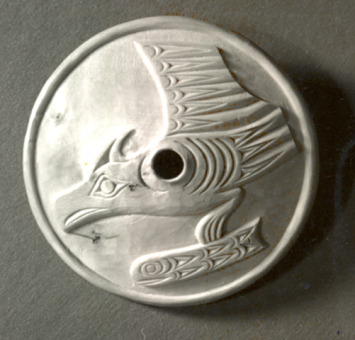
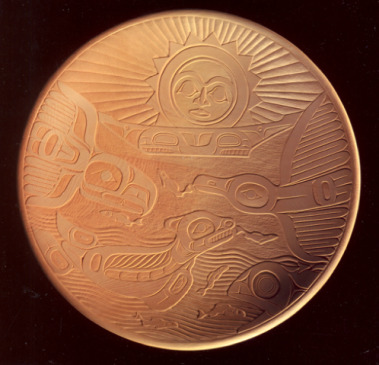

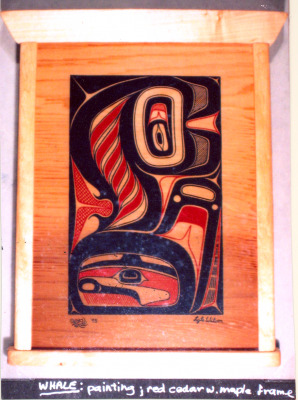
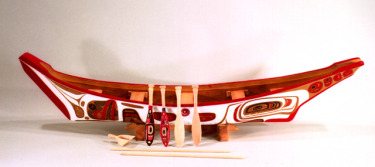

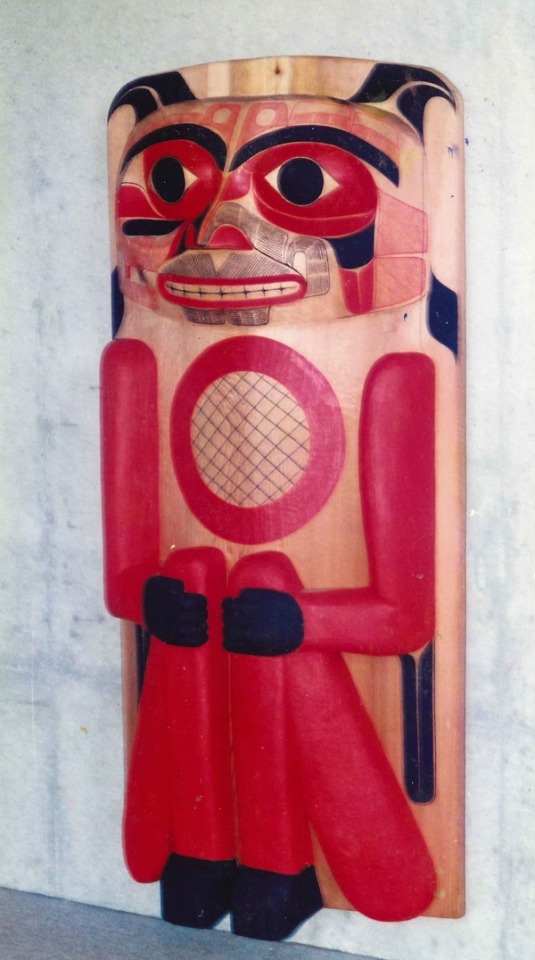

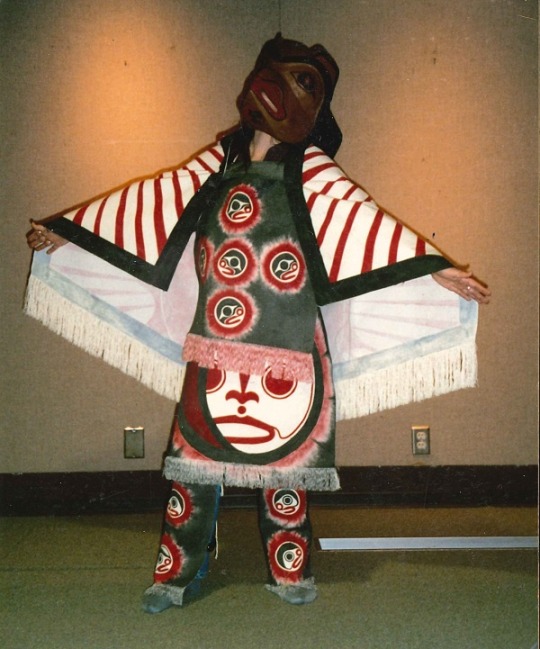

LYLE WILSON: KITAMAAT HAISLA ARTIST.
Lyle Wilson is a Haisla artist from British Columbia: born at C’idax (Butedale Cannery); spent his early years in Kitamaat Village; moved to the town-site of Kitimat from grade 4-9; then moved back to Kitamaat Village from grade 10-12; after graduating from Mount Elizabeth Secondary School, he worked at Alcan for a year before eventually moving to Vancouver to seek a post-secondary education at the University of British Columbia and the Emily Carr College of Art and Design.
The Haisla people are often referred to as Northern Kwakuitl, however their historic artistic style is, mainly, influenced by the Kwakuitl, Tsimshian, Bella Bella and Bella Coola. The name Kitamaat means “People of the Snow“; which refers to the large snow-fall during the winters. Tsimshian guests who visited the Haisla in mid-winter arrived to see people emerging from traditional bighouses that were completely buried by the snow. Thus, the name Kitamaat was given to the Haisla.
The Haisla Clan system was originally matrilineal and, although he was born into the Beaver Clan, Lyle was formally adapted into his father’s Eagle Clan. Due to high death rates at that time, his Eagle grandmother adapted both Lyle and his sister to bolster the numbers of the Eagle Clan (his sister has now returned to the Beaver Clan).
“I was always aware, and appreciative, of Haisla art after seeing a few old carvings at village places/events. My first living artistic influence was my uncle Sam Robinson — a full-time carver who carved at a time-period when everyone assumed Pacific Northwest Coast carving was a dying art-form consigned to the past; consequently, there was no wide-spread recognition of Northwest Coast art as there is now.
I watched Sam and occasionally whittled to the best of my ability. I didn’t really seriously consider art as a profession until after attending the University of British Columbia — I enrolled, & completed, 5 years of the N.I.T.E.P. and Secondary Art Education programs.
I found time in the studio more interesting and eventually left UBC for further studies at the Emily Carr College of Art and Design (now the Emily Carr University of Art & Design). I graduated with a print-making diploma and began to try develop an individual artistic style — using my life experiences, formal education at UBC and ECUAD as the roots in all my art work: prints, wood carvings, paintings, drawings and gold/silver jewellery.
I also prefer working by myself, because I believe that the individual personality shows itself in the finished work — so I’m reluctant to involve others in my artistic projects unless absolutely necessary. Even the extra large carving I try to do mostly myself so I can keep my personality in my work.
I’m one of the few Pacific Northwest Coast artists fortunate to have an extensive formal, post-secondary education. I’m a life-long student/carver who has interests in numerous areas that — hopefully — enrich whatever work I produce.”
LYLE WILSON. (c) 778-846-3520
SELECTED GROUP & SOLO EXHIBITIONS
2016: “HAISLAKALA: SPOKEN FROM THE HEART”: Nov. 5; solo jewellery exhibition at the Coastal Peoples Fine Arts Gallery, Vancouver, B.C.
“PAINT: THE PAINTED WORKS OF LYLE WILSON”: this solo show was shown at the following venues:
2016: Museum of Northern BC, Prince Rupert, B.C. 2014: Whatcom Museum’s Lightcatcher Gallery; Washington State, U.S.A. 2013: Kitimat Museum & Archives, Kitimat, B.C. 2013: Bill Reid Gallery, Vancouver, B.C. 2012: Maple Ridge Art Gallery, Maple Ridge, B.C.
2009: “CHALLENGING TRADITIONS: CONTEMPORARY FIRST NATIONS ART of the NORTHWEST COAST”: group exhibition at the McMichael Canadian Art Collection, Ontario.
2009: “NORTH STAR: THE ART OF LYLE WILSON”: solo exhibition at the West Vancouver Museum, West Vancouver , B.C.
2004: “TOTEMS TO TURQUOISE”: group exhibition at the American Museum of Natural History, New York. ~ this exhibition also travelled to the Vancouver Museum in 2005
2004: “TOTEMS: SILENT MESSENGERS OF THE WEST COAST”: group exhibition at the Coastal Peoples Gallery, Vancouver, B.C.
2003: “NORTHWEST COAST COLLECTIONS”: group exhibition at the Inuit Gallery, Van., B.C.
2001: “RAVEN STORIES”: group exhibition at the Inuit Gallery, Van., B.C.
2001: “NORTHWEST INNOVATIONS: TRANSFORMING TRADITIONS”: group exhibition at the Evergreen Cultural Centre Art Gallery, Coquitlam, B.C.
2000: “TIME & TIDE”: group exhibition at the Inuit Gallery, Vancouver, B.C.
PUBLIC COMMISSIONS
2007: “ORCA CHIEF“ ~19 foot by 17 foot, water-jet cut, powder painted layered aluminum wall-sculpture at the Vancouver International Airport, Van..
1999:1) “KILLER WHALE“. 2) “DANCE FOR THE FIRST CATCH“. 3) “COASTAL SCENE“: 4 separate panels that make one whole scene. ~6 foot by 9 foot canvas screens at the Museum of Anthropology at UBC, Van..
1995: “THE PADDLER“. ~ 10 foot red cedar totem sculpture at the BC Sports Hall of Fame, Van..
1994: “EAGLE, FISH & BEAVER“. ~ 12 foot red cedar totem-sculpture, Canadian Consulate @ Osaka, Japan.
1993:1) “NOOMIS, THE BLIND MAN”. 2) “THE LOON”. 3) “SALMON“. 4) “SALMON“. 5) “GRIZZLY BEAR“. ~ 5 high relief carved, yellow cedar panels @ the Canadian Institute for the Blind, Vancouver, B.C..
1992: “GRIZZLY BEAR DANCER“. ~ motor-animated tranformation mask with costume for the B.C. Pavillion at Expo 1992, Seville, Spain. ~ now on display at the University of Northern British Columbia, Prince George, B.C..
1992: “EAGLE & BEAVER“. ~ 12 foot red cedar house-post sculpture @ the UBC First Nations House of Learning, Vancouver, B.C..
RELATED PROJECTS
1995: “HAISLA HOUSE-POST“. ~ 6 foot red cedar replicated carving of old artifact @ the Museum of Anthropology @ UBC — artist donated the carving to the Haisla Community School, Kitamaat Village, B.C..
1992: “EULACHON: A FISH TO CURE HUMANITY“. ~co-curated this catalogued exhibition documenting the historical & contemporary usage of the eulachon fish; opened @ the UBC Museum of Anthropology , Vancouver, B.C. .
1988: “IMAGE RECOVERY PROJECT“. ~using an infra-red camera, historical images were photographed, archived & replicated; this is the most intensive documentation of painted images of historical work undertaken to this date .
1987: “NORTHWEST COAST TRADITIONAL BIGHOUSE PROJECT “. ~ assistant co-ordinator/liaison for the planning, building of 6 different Northwest Coast Bighouses @ the UBC Museum of Anthropology; the bighouses were installed @ the Canadian Museum of Civilization, Quebec .
EDUCATION
1987: 5th Year, Secondary Art Education Department at the University of British Columbia, Vancouver, B.C..
1988: Graduated with diploma from the 4 Year Print-making Department at the Emily Carr College of Art and Design (now the Emily Carr University of Art & Design, Van., B.C..
1976-1979: Native Indian Teacher Education Program at the University of British Columbia, Van., B.C..
PUBLICATIONS
2012: “SEEKERS and TRAVELLERS: CONTEMPORARY ART of the PACIFIC NORTHWEST COAST” Gary Wyatt.
2012: “PAINT: THE PAINTED WORKS OF LYLE WILSON” Lyle Wilson.
2010: “THE TOTEM POLE: AN INTERCULTURAL HISTORY“ Aldona Jonaitis & Aaron Glass.
2004: “TOTEMS TO TURQUOISE: NATIVE NORTH AMERICAN JEWELLERY ARTS of the NORTHWEST and SOUTHWEST“ Kari Chalker, Lois S. Dubin, Peter M. Whitely; eds. .
COLLECTIONS
~ Royal British Columbia Museum. ~Museum of Anthropology at UBC. ~UBC Faculty of Education. ~First Nations House of Learning. ~Vancouver Art Gallery. ~Vancouver International Airport. ~Burnaby Art Gallery. ~Toronto Dominion Bank. ~Canada Council Art Bank. ~Imperial Esso. ~West Vancouver Museum. ~BC Sports Hall of Fame. ~Canadian Institute for the Blind. ~Kitimat Museum and Archives. ~ Haisla Nation Council. ~ Haisla Community School. ~ Museum of Northern BC
All information is from the Haisla website.
9 notes
·
View notes
Text
Catch the light
Catch the light - something fishy is casting a light over the mystery of life.
There is something about nature, about life, about fishes – light is almost synonymous with life, the source of everything in nature… and this has inspired people to a level of creativity combining fishes with light.
Those designing the various electrical fish lights may consider themselves very creative, but in fact, greasy fishes have been used for ages as candles. Sometimes by sticking a…
View On WordPress
#-Mykiss-#Angling#Bioluminescence#Candlefish#David Attenborough#Elephant#Eulachon#Fish#Fishing#Frank Gehry#Inocuo The sign#IQ Puzzle Jigsaw Lamp#Isidro Ferrer#Koi#LZF#Minke van Voorthuizen#Moree#Pols Potten#Shark#VLightDeco
0 notes
